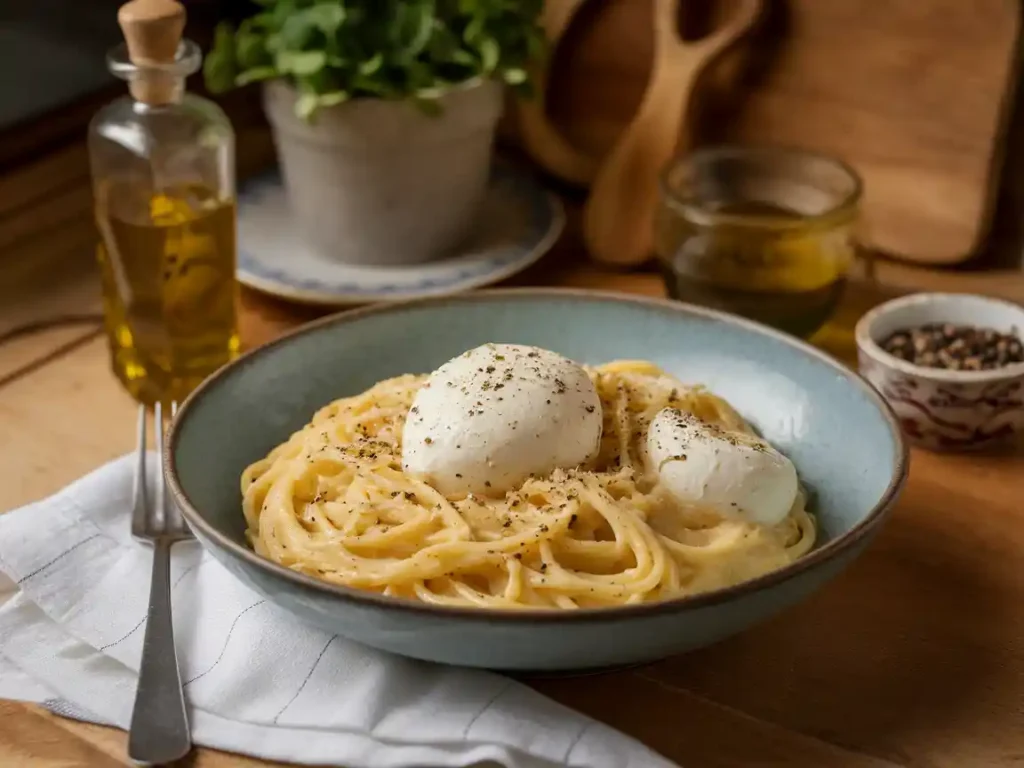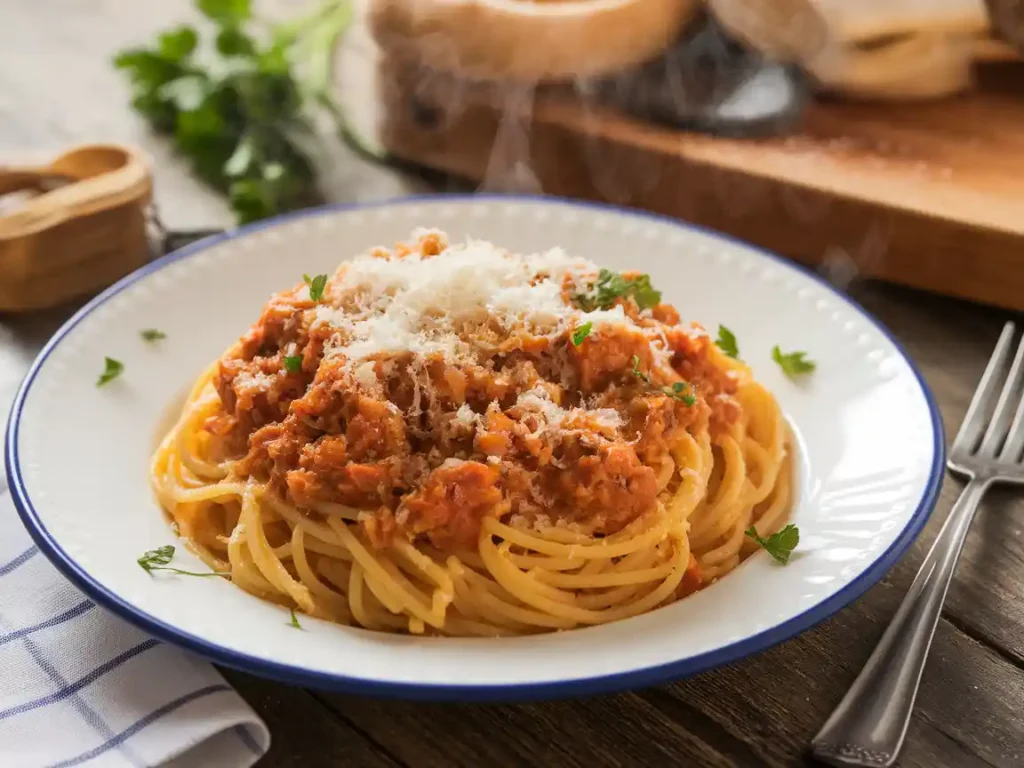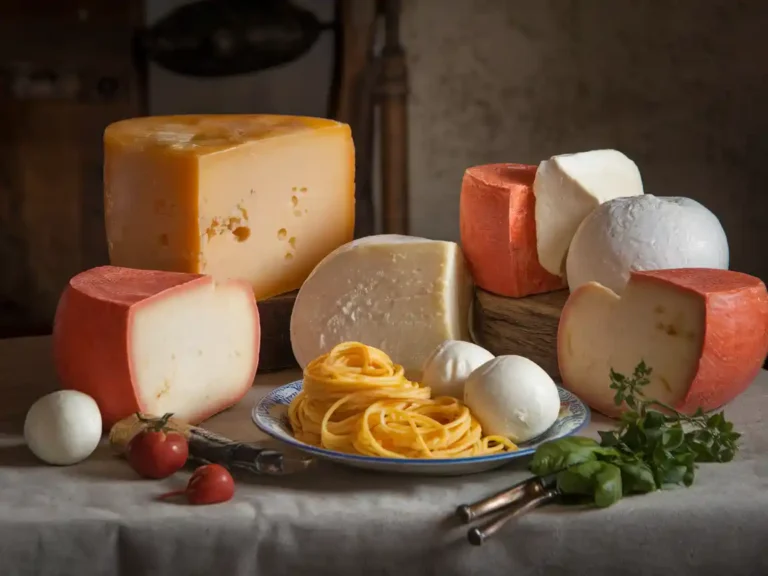There’s something undeniably satisfying about a plate of spaghetti, but the right cheese can take it to the next level. Whether you’re savoring a rich Bolognese, a creamy carbonara, or a simple aglio e olio, the right cheese enhances flavor, texture, and overall indulgence. But with so many options to choose from, which cheeses work best? In this guide, we’ll explore the best cheeses to pair with spaghetti and how each one transforms your dish into a mouthwatering masterpiece. 🍝🧀
Table of Contents
What Cheeses Are Good on Spaghetti?
There’s something magical about a plate of spaghetti topped with just the right cheese. Whether it’s a classic spaghetti Bolognese, a creamy carbonara, or even a simple aglio e olio, adding cheese can transform your dish into a culinary masterpiece. But not all cheeses are created equal when it comes to pairing with spaghetti. So, what cheeses are good on spaghetti? Let’s dig into the details!
Why Cheese Enhances Spaghetti
Cheese has an almost mystical ability to bring spaghetti dishes to life. It’s not just about sprinkling some grated cheese on top it’s about the way cheese complements the flavors and textures of the dish, adding depth and richness that takes it to another level.
The Role of Cheese in Italian Cuisine
Italian cuisine has a long-standing love affair with cheese. From Parmigiano-Reggiano to Pecorino Romano, cheese is a staple ingredient that reflects the country’s culinary traditions. In Italian cooking, cheese isn’t just an afterthought; it’s a carefully chosen component that works harmoniously with the dish’s other elements. For example, in recipes like spaghetti carbonara, Pecorino Romano isn’t just an addition it’s essential to the sauce’s creamy texture and salty bite.
Texture and Flavor Pairings with Spaghetti
Pairing cheese with spaghetti isn’t just about flavor; texture plays a huge role too. Hard cheeses like Parmigiano-Reggiano offer a satisfying crumble that melts into sauces, while softer options like ricotta add creaminess. The right cheese enhances the spaghetti’s texture, balancing the chewiness of the noodles with either a rich melt or a tangy topping. Additionally, the flavor profile matters nutty, salty, or even sharp cheeses can complement or contrast with your sauce to create a perfect bite.
Popular Types of Spaghetti Dishes That Use Cheese
Cheese and spaghetti are a match made in heaven, and some iconic dishes showcase this pairing to perfection. Let’s take a closer look at how cheese is used in popular spaghetti recipes:
Classic Spaghetti Bolognese
Ah, spaghetti Bolognese a dish that feels like a warm hug. Traditionally, a sprinkle of Parmigiano-Reggiano or Grana Padano is the go-to choice for topping this meaty, tomato-based sauce. The cheese’s nutty and salty flavors blend seamlessly with the rich, slow-cooked ragu. Want to experiment? Try Pecorino Romano for a sharper kick.
Spaghetti Carbonara
When it comes to carbonara, cheese is a star ingredient. This Roman classic relies on Pecorino Romano for its sharp, tangy flavor, which pairs beautifully with the creamy egg-based sauce. Parmigiano-Reggiano can also work as a milder substitute, but purists will insist on the Pecorino. And let’s be honest this dish wouldn’t be the same without that cheesy backbone.
Spaghetti Aglio e Olio with Cheese Variations
Spaghetti aglio e olio is simplicity at its finest, but adding cheese can elevate it into something truly special. While the original recipe doesn’t include cheese, many modern variations sprinkle a little Pecorino Romano or Parmigiano-Reggiano for added richness. For a creamy twist, a dollop of ricotta can also be stirred in.
How to Choose the Right Cheese for Spaghetti
With so many cheeses to choose from, how do you know which one is right for your dish? A few key factors can help guide your decision:
Factors to Consider: Melting Point, Flavor, and Texture
- Melting Point: Not all cheeses melt the same way. Hard cheeses like Parmigiano-Reggiano melt into fine granules, while mozzarella creates gooey, stretchy textures perfect for baked dishes.
- Flavor: The intensity of the cheese should match your sauce. Bold cheeses like Pecorino Romano shine in rich, meaty sauces, while mild cheeses like mozzarella work well in lighter dishes.
- Texture: Hard cheeses add a crumbly, granular texture, while soft cheeses like ricotta or burrata lend creaminess to your spaghetti.
Hard Cheeses vs. Soft Cheeses
Hard cheeses like Parmigiano-Reggiano and Pecorino Romano are classics for a reason they grate beautifully, melt evenly, and pack a flavor punch. Meanwhile, soft cheeses like ricotta and burrata are ideal for creamy sauces or as a luxurious garnish.
Pairing Cheeses with Sauce Types
The type of sauce you’re using plays a huge role in determining the best cheese. For tomato-based sauces, hard cheeses with salty, nutty profiles work best. Cream-based sauces, on the other hand, benefit from soft cheeses like ricotta or mascarpone. Olive oil-based sauces, such as aglio e olio, pair well with lighter cheeses or just a dusting of Parmigiano.
Traditional Cheeses Used in Spaghetti Dishes
When it comes to choosing cheese for spaghetti, some classics never go out of style. Traditional Italian cheeses, loved for their rich history and bold flavors, have been staples in spaghetti recipes for centuries. Let’s dive into the most popular options and discover why they’re still the gold standard.
Parmigiano-Reggiano: The King of Hard Cheeses
Parmigiano-Reggiano, often referred to as “the king of cheeses,” is a must-have for spaghetti lovers. Its sharp, nutty flavor and crumbly texture make it a versatile choice that works in countless recipes.
Why It’s Perfect for Spaghetti
Parmigiano-Reggiano isn’t just a topping; it’s an enhancer. Its ability to melt gently into a dish, without overpowering the other ingredients, makes it the ultimate partner for spaghetti. It provides depth to tomato-based sauces, richness to creamy varieties, and even a savory kick to simpler dishes like spaghetti aglio e olio. Plus, its long aging process (typically 24-36 months) results in those delightful, crunchy crystals that add an extra layer of texture.
How to Use Parmigiano-Reggiano in Different Spaghetti Recipes
You can use Parmigiano-Reggiano in several ways: grate it over your favorite spaghetti, incorporate it into sauces for a velvety texture, or mix it with breadcrumbs for baked dishes. For example, try sprinkling it generously over a piping hot plate of spaghetti Bolognese, or stir it into an Alfredo sauce for an ultra-creamy finish.
Pecorino Romano: A Salty and Sharp Option
Pecorino Romano, made from sheep’s milk, offers a bolder and saltier flavor compared to Parmigiano-Reggiano. Its sharpness pairs beautifully with rich, hearty spaghetti dishes, making it a go-to choice for many Italian recipes.
Key Dishes Featuring Pecorino Romano
One of the most famous uses of Pecorino Romano is in spaghetti carbonara. Its sharp, salty profile perfectly complements the creamy egg-based sauce, crispy pancetta, and al dente pasta. Additionally, Pecorino Romano works wonderfully in cacio e pepe, a simple yet flavorful dish that relies on the cheese’s bold flavor to shine.
Grana Padano: A Milder Alternative
If you find Parmigiano-Reggiano or Pecorino Romano a bit too intense, Grana Padano might be the perfect compromise. This hard cheese is slightly milder and creamier, but still offers that characteristic nuttiness.
Flavor Profile and Best Uses
Grana Padano’s subtle flavor makes it an excellent choice for spaghetti dishes with lighter sauces. It works well in recipes where the cheese’s role is to enhance rather than dominate. For instance, it’s perfect for a light tomato and basil spaghetti or a delicate seafood pasta.
Soft and Semi-Soft Cheeses for Spaghetti

While hard cheeses are often the go-to, soft and semi-soft cheeses can add creaminess and a unique twist to your spaghetti dishes. These cheeses are ideal for those who love a bit of indulgence.
Mozzarella: Adding Creaminess to Spaghetti Bakes
Mozzarella, known for its gooey, stretchy texture, is a favorite in baked spaghetti recipes. Its mild flavor lets other ingredients shine while adding a luscious, melty layer.
Fresh vs. Shredded Mozzarella
Fresh mozzarella, with its creamy texture and subtle taste, is ideal for layering in baked dishes like spaghetti casseroles. Shredded mozzarella, on the other hand, melts quickly and is perfect for topping spaghetti bakes, creating that golden, bubbly crust everyone loves.
Ricotta: A Versatile Cheese for Creamy Sauces
Ricotta’s mild, slightly sweet flavor and creamy texture make it an excellent addition to spaghetti. Whether used as a base for sauces or dolloped on top, it brings a luxurious element to the dish.
Recipes Combining Ricotta with Spaghetti
Try mixing ricotta with herbs and a splash of lemon juice for a light, creamy spaghetti sauce. Alternatively, layer it into a baked spaghetti dish alongside marinara and mozzarella for a hearty, satisfying meal.
Burrata: A Luxurious Addition
Burrata, with its creamy center and firm outer shell, takes spaghetti dishes to a whole new level. Its rich texture and buttery flavor work best as a finishing touch rather than an ingredient cooked into the dish.
Unique and Regional Cheeses to Experiment With
If you’re feeling adventurous, there are plenty of unique and regional cheeses to explore. These options can introduce new flavors and textures to your spaghetti dishes, helping you break away from the usual choices.
Gorgonzola: A Blue Cheese Twist
Gorgonzola, a type of blue cheese, brings a bold and tangy flavor to spaghetti. It’s perfect for creamy sauces or as a garnish for olive oil-based pasta dishes. A little goes a long way, so use it sparingly to avoid overpowering the dish.
Asiago: A Bold and Nutty Choice
Asiago, with its nutty and slightly tangy flavor, is a great alternative to Parmigiano-Reggiano or Pecorino Romano. Use it grated over spaghetti dishes or incorporate it into sauces for an added depth of flavor.
Caciocavallo: A Southern Italian Favorite
Caciocavallo, a stretched-curd cheese, is beloved in Southern Italy for its unique flavor and melting properties. It’s a fantastic option for baked spaghetti recipes, where its creamy melt and slightly tangy flavor can truly shine.
How These Cheeses Elevate Flavor
Adding regional cheeses like Gorgonzola, Asiago, or Caciocavallo can completely transform a dish. They bring new dimensions of flavor that make your spaghetti feel more sophisticated and exciting. Experimenting with these cheeses is a great way to add variety to your usual pasta night.
Practical Tips for Adding Cheese to Spaghetti
Adding cheese to spaghetti isn’t as straightforward as it might seem. Sure, you could sprinkle some grated cheese and call it a day, but there’s an art to incorporating cheese that enhances your dish. From choosing the right cheese to mastering specific techniques, there are many ways to elevate your spaghetti game.
Techniques for Incorporating Cheese into Spaghetti Dishes
The way you use cheese in your spaghetti dish can significantly affect the final result. Whether you’re looking for a gooey, melted layer or just a flavorful garnish, the technique matters.
Grating and Melting Techniques
Grating cheese might seem basic, but the size of the grates can impact how the cheese melts. Fine grating allows cheese like Parmigiano-Reggiano to integrate seamlessly into hot pasta, creating a silky coating. Coarser grates, meanwhile, are better for visual appeal and texture. If you’re melting cheese into a sauce, it’s essential to add it gradually and stir constantly to avoid clumps.
Using Cheese as a Garnish
Sometimes, less is more. A sprinkle of cheese on top of a finished dish can provide just the right amount of flavor without overwhelming the other ingredients. Hard cheeses like Pecorino Romano or Grana Padano are perfect for this, as their crumbly texture and sharp taste work well in small amounts.
How to Layer Cheese in Baked Spaghetti Recipes
Layering is key when making baked spaghetti. Start with a base of sauce and pasta, then alternate layers of cheese like mozzarella, ricotta, or even a mix of cheeses. The final layer should be mozzarella or another melting cheese to create that golden, bubbly crust.
Combining Multiple Cheeses for Complex Flavors
Mixing different cheeses can take your spaghetti to a whole new level. The key is to balance strong and mild varieties to create a harmonious flavor profile.
Balancing Strong and Mild Cheese Varieties
Pairing sharp cheeses like Pecorino Romano with milder ones like mozzarella can result in a well-rounded flavor. The sharpness provides a tangy kick, while the mild cheese adds creaminess and balance. For example, try combining Gorgonzola with ricotta for a sauce that’s both bold and creamy.
Popular Cheese Blends for Spaghetti

Some tried-and-true blends include:
- Mozzarella and Parmesan: Perfect for baked spaghetti, combining stretchiness with a nutty finish.
- Ricotta, Pecorino Romano, and Grana Padano: Ideal for creamy, layered dishes.
- Asiago and Gorgonzola: A bold combination for olive oil-based pasta sauces.
Pairing Cheeses with Spaghetti Sauces
The type of sauce you’re working with is a critical factor when choosing cheese. The right pairing can highlight the sauce’s flavors and add depth to the dish.
Best Cheeses for Tomato-Based Sauces
Tomato-based sauces are bright and acidic, which means they pair beautifully with salty, hard cheeses like Parmigiano-Reggiano or Pecorino Romano. These cheeses add a savory, umami element that balances the sauce’s tanginess.
Ideal Cheeses for Creamy or Alfredo Sauces
Cream-based sauces call for cheeses that melt smoothly, like mozzarella, mascarpone, or even burrata. Ricotta can also be mixed into Alfredo-style sauces for a lighter, fluffier texture.
Light Cheese Options for Olive Oil-Based Sauces
For simpler sauces like aglio e olio, light cheeses like Grana Padano or even a touch of Pecorino Romano can add just enough flavor without overpowering the dish. Alternatively, a dollop of ricotta or mascarpone can bring creaminess without heaviness.
Summary of the Best Cheeses for Spaghetti
After exploring so many delicious options, let’s wrap up with a quick recap of the best cheeses for spaghetti:
Hard Cheeses for Traditional Recipes
Parmigiano-Reggiano, Pecorino Romano, and Grana Padano are the top choices for classic spaghetti dishes. Their bold, salty flavors and versatile textures make them staples in any kitchen.
Soft Cheeses for Creamy Textures
Mozzarella, ricotta, and burrata are excellent for adding creaminess to your dishes. They work particularly well in baked recipes or as part of creamy sauces.
Specialty Cheeses for Experimentation
If you’re looking to get creative, try regional options like Gorgonzola, Asiago, or Caciocavallo. These cheeses bring unique flavors and textures that can elevate your spaghetti dishes to something truly memorable.
FAQs About Cheeses and Spaghetti
If you’re still wondering about some finer points of pairing cheese with spaghetti, don’t worry we’ve got you covered. Below are answers to some of the most common questions about this delicious topic.
What Is the Best Cheese for Spaghetti?
The best cheese depends on the type of spaghetti dish you’re making. For traditional recipes like Bolognese or carbonara, hard cheeses such as Parmigiano-Reggiano or Pecorino Romano are ideal. These cheeses have bold, salty flavors that complement rich, savory sauces. However, if you’re creating a creamy or baked spaghetti dish, softer cheeses like mozzarella or ricotta are excellent choices. That said, don’t be afraid to experiment there’s no one-size-fits-all answer!
Can You Use Cheddar Cheese on Spaghetti?
While cheddar cheese isn’t traditionally used in Italian cooking, it can be a fun addition if you’re making a fusion-style dish. Cheddar melts beautifully and has a sharp, tangy flavor that works surprisingly well in baked spaghetti recipes. However, it’s not a great match for classic Italian sauces like marinara or carbonara, as its flavor can clash with the dish’s more traditional elements.
What Cheese Works Best with Spaghetti Bolognese?
Parmigiano-Reggiano is the gold standard for spaghetti Bolognese. Its nutty, umami-packed flavor enhances the richness of the meaty sauce. Pecorino Romano is another excellent option if you prefer a sharper, saltier bite. For a creamier finish, you could also try a blend of Parmigiano and mozzarella perfect for baked versions of this classic dish.
Is Mozzarella a Good Choice for Spaghetti?
Absolutely! Mozzarella is a fantastic choice, especially for baked spaghetti dishes. Its gooey, melty texture creates that irresistible cheesy pull everyone loves. Fresh mozzarella can also be used in lighter dishes, such as spaghetti with olive oil or fresh tomato sauces. However, it’s best paired with other cheeses if you’re looking for a flavor boost, as mozzarella is quite mild on its own.
What’s the Difference Between Parmigiano-Reggiano and Pecorino Romano?
Both are hard Italian cheeses, but they differ in a few key ways. Parmigiano-Reggiano is made from cow’s milk and aged for at least 12 months, resulting in a nutty, slightly sweet flavor. Pecorino Romano, on the other hand, is made from sheep’s milk and has a saltier, sharper taste. When deciding between the two, consider your dish Parmigiano works well in creamy or delicate recipes, while Pecorino’s bold flavor pairs better with hearty, robust sauces.
Are Non-Dairy Cheese Options Suitable for Spaghetti?
Yes, non-dairy cheese options can be used for spaghetti dishes. Many plant-based cheeses, such as almond- or cashew-based Parmesan alternatives, work well as toppings. For creamy sauces, vegan mozzarella or ricotta made from coconut milk or tofu can be great substitutes. While they may not perfectly mimic the taste of traditional cheeses, non-dairy options are becoming increasingly tasty and accessible.
Can You Mix Multiple Cheeses in One Spaghetti Dish?
Definitely! Combining multiple cheeses is a great way to create complex flavors. For example, a blend of mozzarella and Parmigiano-Reggiano adds both creaminess and depth to a baked spaghetti dish. Or, you can pair a strong cheese like Gorgonzola with a mild one like ricotta for a creamy, flavorful sauce. Just remember to balance the flavors so that no single cheese overwhelms the dish.

